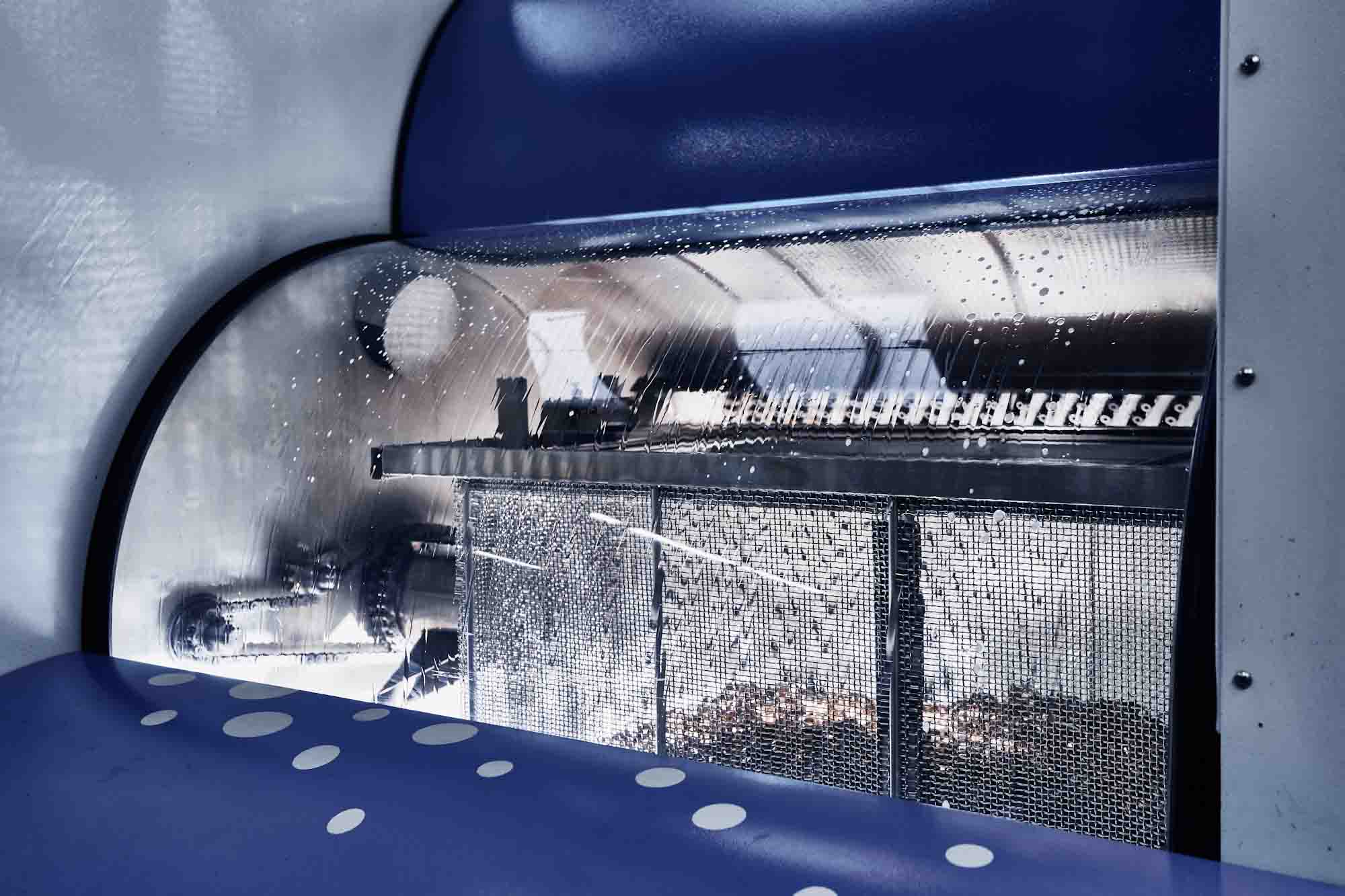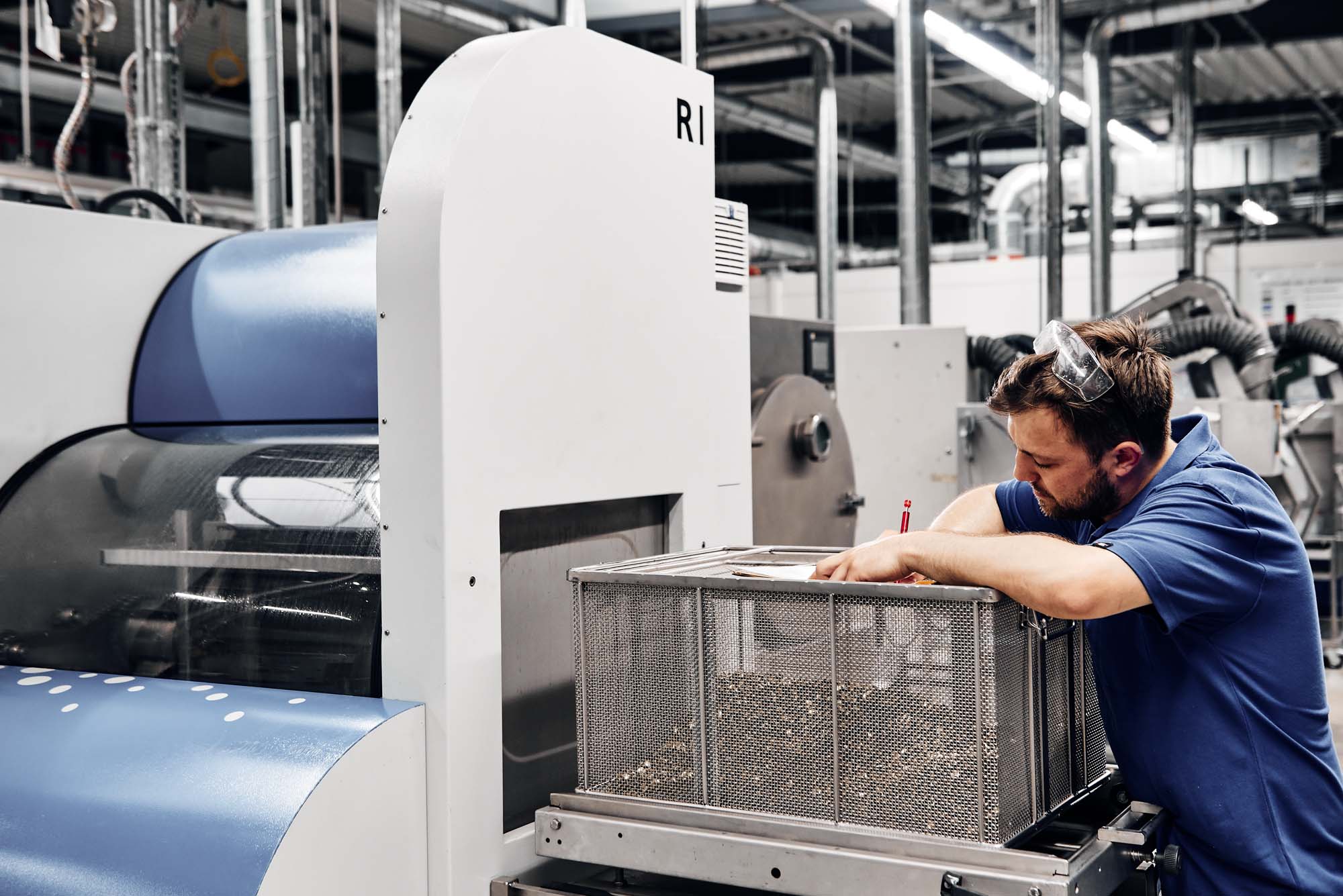11.2019
Cost-savings through use of patented plasma unit for PWIS/LABS cleaning and coating of elastomeric components
The use of plasma for the treatment, cleaning and refinement of component surfaces has long been a technical standard in industry. Low-pressure plasma is indispensable, especially when dealing with the coating, bonding or lacquering of elastomeric and other polymer components. However, not all plasma units can achieve the same effects within comparable times. The new and patented plasma equipment technology from APO GmbH provides savings potentials for the cleaning and coating of components.
The term ‘plasma’ comes from the Greek language and means ‘structure’. Physics defines plasma as a mixture of particles at the atomic-molecular level. However, plasma is often called the fourth physical state of matter: Continuous energy supply transforms solid matter into a liquid state, then into gas. Finally, when supplying more energy the gas will be ionized and transformed into plasma, the fourth physical state.
During this ionization process, different effects can be observed. First, the energy breaks the chemical bonding of gas molecules, which results in very reactive radicals. At the same time, electrons are removed from their atomic shell forming free electrons and ions in the plasma. Simultaneously, energy induces some of the electrons and raises them to a higher energy level in the atomic shell. When the electrons fall back to their original energy level, electromagnetic radiation is released.
Thus, plasma is an ionized gas containing free electrons, ions, induced atoms, radicals, molecule fragments and photons. Normally, plasma is quasi-neutral, that is to say the electric charge of the ions and the electrons are nearly balanced.
In everyday life, we encounter plasma in lightning flashes, xenon headlights or the northern lights at the Arctic Circle.
Compared to the original gas, plasma stands out for its higher conductivity and chemical reactivity. These are the properties used in technical applications.
Different types of plasma
To distinguish between the various plasma types, several criteria can be used. Amongst others, these are; the plasma density, the plasma temperature, the plasma pressure.
Depending on the plasma pressure, a distinction is made between high-pressure plasmas, atmospheric or normal-pressure plasmas and low-pressure plasmas.
High-pressure plasma has significantly higher pressure compared to our atmosphere. It is well known from high-pressure glow-discharge lamps and in nature as bolts of lightning.
The pressure of atmospheric-pressure plasma is comparable with our atmosphere. No reaction chamber is necessary for the industrial generation of atmospheric-pressure plasma. This is a significant advantage over high and low-pressure plasma. The technical use of this plasma type includes the cleaning and activation of component surfaces in atmospheric conditions. However, in general, the temperature of atmosphere-pressure plasma is rather high. Thus, its use for the treatment of temperature-sensitive materials is limited.
Low-pressure plasma is generated in gases with a significantly lower pressure compared to our atmosphere. Typically, technical low-pressure plasmas are generated within vacuum chambers.
Low-pressure plasma is normally cold, that is to say the different particles of the plasma are not in thermal equilibrium. The light electrons have a higher temperature than the heavy particles. With reduced pressure, the mean free path length between the particles is rather long. Therefore, no notable energy transmission between the particles takes place. Thus, there is no temperature transmission and no thermal equilibrium. Despite its high energy level, the result is a low-pressure, cold plasma which can be used for the treatment of temperature-sensitive materials.
Effects and field of application of low-pressure plasma
The chemical and physical effects which take place during the low-pressure plasma treatment of components depend on the effective pressure within the plasma chamber, the process gases used and the excitation frequency for the plasma generation. In general, sputtering effects, oxidising and reductive reactions can be generated.
These effects and reactions during treatment in low-pressure plasma are used for finest cleaning, activation, structuring and coating of component surfaces. The components’ materials, however, have to be vacuum and plasma resistant for surface treatment with low-pressure plasma. Materials that disturb the vacuum or plasma through considerable outgassing are not suitable for treatment with low-pressure plasma.
Plasma cleaning with low-pressure plasma
Cleaning of components and surfaces is of great importance in technology. It is used in preparation for subsequent coating or bonding processes to improve the adherence of lacquers, coatings or adhesives. Alternatively, it is used as a finest cleaning, e.g. as known from LABS/PWIS cleaning (LABS/PWIS = paint wetting impairment substances), to ensure safe use of the cleaned component in paint booths and similar sensitive areas.
Very clean surfaces can be achieved with low-plasma treatment. Even components with complex design and small cavities can be cleaned efficiently given that plasma can penetrate even the smallest clearances.
The following cleaning effects take place depending on the selected process gas and excitation frequency:
- Removal of organic residues through oxidation (chemical reaction)
- Removal of interfering oxide layers through chemical reduction
- Physical removal of contamination through sputtering effects (“blasting” with heavy ions)
The typically generated reaction products are gaseous and volatile and can be easily removed from the vacuum chamber.
Cleaning with low-pressure plasma is only suitable for rather thin organic or oxide containing contamination layers. It is not suitable for the removal of thick or inorganic contamination. However, the combination with wet-chemical primary cleaning processes allows for the removal of both heavy contamination and organic residues including potentially remaining cleaning agents.
Plasma activation of polymer surfaces
Owing to their predominant non-polar character and the appropriate low surface energy level, it is almost impossible to wet, coat or bond polymer materials. It is necessary to increase the surface energy of polymers beforehand to ensure wettability and bonding with coatings and adhesives.
By means of low-pressure plasma treatment, polar groups are generated on the polymer material surface, which increases its interface surface energy. Depending on the selected process gas, polymer material surfaces are functionalised by generating reactive points, e.g. through hydroxyl groups. Thereby, the polymer’s affinity towards adhesives, coatings and paint is increased. Thus, during subsequent coating or gluing processes, chemical bonding can materialise between the polymer component and the coating or adhesive.
Plasma coating
In addition to the effects mentioned above it is also possible to deposit functional layers on components. These processes are called plasma polymerisation or PECVD (Plasma Enhanced Chemical Vapour Deposition). During such plasma induced material deposition, the fed process gas is deposited on the substrate surfaces out of the gaseous phase. Depending on the fed process substance, different properties can be achieved. Besides visual modification, it is possible to increase the surface hardness or to create hydrophilic or hydrophobic layers.
The necessary plasma cleaning and activation of the substrate surface is normally integrated in the complete process.
Plasma etching and surface structuring
Finally, it is possible to etch and structure different material surfaces using low-pressure plasma. During the plasma treatment, surfaces are roughened and structured through selective material stripping. In this way it is possible, for example, to prepare materials for coating or bonding when activation in plasma is normally insufficient.
Low-pressure plasma – The optimum preparation of elastomer and polymer materials for coating and lacquering
The best possible preparation and activation of component surfaces is an essential precondition for optimum wetting and firm adherence of coatings and lacquers. This is especially true in the use of water based coating systems when grease, oil or contamination containing silicone must be efficiently removed.
Low-pressure plasma combined with wet cleaning is a sustainable and harmless alternative for the cleaning and activation of elastomer and plastic components compared to traditional solvent-based methods. It is possible to adapt the process gases and parameters ideally to both the component material and the application.
For batch processing of small mass-produced parts, drums which can be integrated in the plant are required in order to move the components around in the low-pressure plasma during treatment. Consistent movement is necessary for the all-over treatment of small components in large quantities.
Different excitation frequencies
To generate plasma at low-pressure, a process gas is excited by an appropriate energy supply. Apart from the type of process gas, the excitation frequency has an impact on the specific plasma properties and effects.
Typically, three different frequency ranges are used for the above-mentioned possible applications of low-pressure plasma:
Low-frequency plasma (LF) at 40 kHz, high-frequency plasma (HF) at 13.56 MHz, also known as radiofrequency plasma (RF) and microwave plasma (MW) at 2.45 GHz.
In general, there is no correct or best frequency range. The decision for the frequency range depends on the plasma unit’s intended use, the desired effects, the components and materials to be treated and finally, on the planned investment and maintenance costs. Hereafter, we take a closer look at low frequency and high frequency excitation.
Low-frequency plasma (NF, 40 kHz)
Low-frequency excitation has proved practicable in recent years for the cleaning and activation of small mass-produced parts which can be treated in batches. Thus, especially for cleaning, activation and coating of elastomer and plastic components, the use of low-frequency plasma at 40 kHz is quite common.
The plasma generated in this way is fairly homogenous although its density is rather low. The ion energy is quite high, which intensifies the sputtering effects, but is still very usable and controllable.
Due to the low plasma density, reactions in low-frequency plasma take place at a somewhat slow rate compared to plasma excited at higher frequencies. Thus, process times for achieving the required cleaning and activation effects are correspondingly longer.
With this kind of equipment, the plasma is often generated directly in the treatment chamber using the mechanical parts, such as treatment basket and unit casing, as anode and cathode for the excitation. Thereby all components in the chamber are loaded with the alternating electrical field. For components with small clearances, this can lead to flashover in extreme cases.
As the equipment is comparatively robust and yet affordable in terms of purchase and maintenance, low-frequency plasma units have been favoured up to now. Attractive technical alternatives with high-frequency excitation have been rare so far.
High-frequency or radio-frequency plasma (RF or HF, 13.56 MHz)
The use of high-frequency excitation offers a couple of advantages concerning the efficiency during the plasma treatment of elastomer and other plastic components.
Plasma produced in this way shows higher density combined with mean ion energy and thus lower sputtering effects compared to low-frequency excitation. However, high-frequency plasma is slightly less homogenous than low-frequency plasma.
When designed conventionally, the mechanical parts of the plasma unit are often exposed to higher load through heat input during plasma generation and through the plasma itself. Thus, compared to low-frequency plasma excitation the mechanical parts are exposed to higher wear.
Also, comparably higher purchase and maintenance costs have prevented the wider use of plasma units with high-frequency excitation for the treatment of small mass-produced parts.
New and patented low-pressure plasma unit with high-frequency excitation (HF, 13.56 Mhz)
With the development of a new and, meanwhile, patented low-pressure plasma unit with high-frequency excitation, APO GmbH has succeeded in using the advantages of high-frequency technology for the cleaning and activation of small parts while eliminating its downsides.
Through the optimised layout of both equipment and mechanical parts and the smooth integration of the plasma unit into the production flow, APO has increased the efficiency in cleaning and activation of components, while simultaneously improving occupational health and safety.
Direct benefit of the optimised plasma unit layout
Although the overall concept of the equipment layout and the integration into APO’s production flow are key factors for the efficiency and benefit of the new plasma unit, it is possible to highlight some individual points.
- Increase in efficiency through external plasma source combined with variable capacity:
For the plasma generation, the new unit is equipped with an external, decoupled plasma source. Thus, the mechanical parts are relieved from excitation voltage and heat introduction. The systematic input and dispersion of the plasma cloud via vacuum provides improved plasma homogeneity. All components in the rotating baskets are moved around close to the plasma source, being in free fall when directly beside it. These measures, combined with the variable capacity of up to 5 kW, provide higher efficiency and reduced plasma process times. Depending on the components and the required effects, treatment times can be reduced by up to 90%. - Rotating drum with improved bearings and optimised handling for process enhancement:
The plasma unit is equipped with a rotating drum which can carry up to three treatment baskets. Both speed and rotating direction are variable in order to optimise cleaning and activation processes. The unit’s bearings are designed to minimise the number of components exposed to the plasma. In this way, it is possible to reduce the equipment’s load and maintenance effort and costs. - Unification of treatment baskets for higher process reliability:
The treatment baskets used in the new plasma unit are identical to those used in the cleaning devices for wet cleaning processes in the complete production. Therefore, it is possible to insert the baskets with pre-cleaned components directly into the plasma unit for further treatment. It is no longer necessary to transfer the components to other treatment baskets, which consequently eliminates any risk of losing or mixing parts and finally improves production process reliability. - Standardised working height to relieve the strain on employees:
The baskets can be positioned precisely for easy loading and unloading at the new plasma unit. The loading height of cleaning devices, tipping appliances and the new plasma unit are perfectly matched. Thus, any tipping of components and change of workstations is facilitated, employees are relieved, especially with regard to the strain on their spine, and the entire process flows smoothly. - Variability of load capacity and process gas for flexible use:
The new APO low-pressure plasma unit has a total net capacity of 1300 litres for treatment of large batch volumes. However, small lot sizes can also be treated by dividing them into several treatment baskets. Separate connections allow the use of three different process gases while the different connection geometries protect against any mix-up of the gases. Thus, in the daily routine of cleaning and coating small mass-produced parts, the plasma processes can be optimally adapted to different components, materials and quantities. - Reduced costs through low-maintenance and maintenance-friendly unit design:
The number of mechanical parts exposed to the plasma or the excitation voltage has been reduced to a minimum. Components subjected to higher wear are easily replaceable using appropriate tools. Thus, maintenance costs are effectively reduced
Conclusion
Using the new, patented, low-pressure plasma unit in production at APO’s small mass-produced parts coating business unit, it is possible to increase the efficiency of LABS cleaning and coating pre-treatment processes for small components. Thus, process times and costs can be significantly reduced. Especially when it comes to the cleaning and coating of various sealing elements, being typical “C” parts, the use of the new plasma unit definitely pays off.



